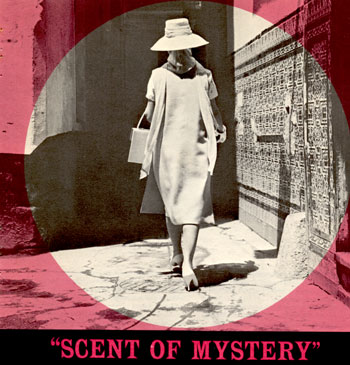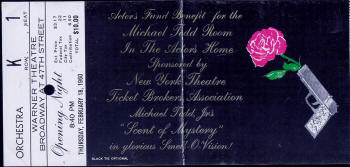"Scent of Mystery"
|
Read more
at in70mm.com The 70mm Newsletter |
| Written by: Rick Mitchell (Film Editor/ Film Director/ Film Historian), Hollywood, USA | Date: 6 March 2005 |
 Since many technological advances in motion pictures have occurred outside
the studio system, often interesting pioneering works, especially those
involving non standard projection formats, are rarely accessible for
contemporary re-evaluation. Since many technological advances in motion pictures have occurred outside
the studio system, often interesting pioneering works, especially those
involving non standard projection formats, are rarely accessible for
contemporary re-evaluation.One such film is "Scent of Mystery" (1959), produced by Michael Todd, Jr., directed by Jack Cardiff, and photographed by John von Kotze. Todd had hoped to follow in the entrepreneurial footsteps of his father, who had been involved in the introduction of Cinerama and initiated the development of Todd-AO, by producing, in an era before vinegar syndrome, the first major film that smelled. (Sorry, I couldn't resist). That aspect of the project is apparently not reproduceable today, fortunately, but the film itself, photographed in 65mm with Mitchell cameras and originally advertised as being in Todd-70, the family having lost the rights to the Todd-AO name, survives, somewhat. Unsuccessful on its January, 1960 release, the film was subsequently acquired by the CineMiracle Corporation, which was itself soon taken over by Cinerama, Inc. Either of them cut the film by about 20 minutes, added some voice-over comments from the main character played by Denholm Elliott, and optically converted it to three panel Cinerama(!), re-releasing the results under the title "Holiday in Spain". I recently [December 2004, ed] had occasion to see all but about two minutes of a faded 70mm print of this version and found it really bewildering. The simple plot involves an English novelist on vacation in Spain who becomes involved in rescuing a beautiful, mysterious woman from assassination. It's supposed to be a light-hearted, picaresque affair, reminiscent of "To Catch a Thief" (1955) and the later "Charade" (1963) or "A Man Could Get Killed" (1966), but it feels more like a work by ambitious beginners. All the rhythms and overall tone are just off and many of the attempts at humor fall flat. More shocking is that there is very little exploitation of the 65mm format, at a time when the big, wide screen presentation was being emphasized. There are few of the famous audience involving POV shots and most of the camera setups are uninteresting. Worse, most of the film is shot in tight medium shots and closeups, much like contemporary so-called "big screen epics", which must have looked awful in three panel Cinerama, since there was no way to keep the actors from being bi and tri-sected by the splits. |
Further
in 70mm reading: Mike Todd, Jr. Interview Scent of Mystery Afterthoughts Mike Todd Jr.'s "Scent of Mystery" in Smell-O-Vision Oliver Michael Todd in Conversation with Thomas Hauerslev Internet link: |
 Opening
night ticket. Press to see
enlargement Opening
night ticket. Press to see
enlargementThis is particularly surprising given the involvement of Jack Cardiff, who so beautifully photographed "The Vikings" (1958) and made incredible use of CinemaScope in "Sons and Lovers" (1960), a textbook example of using wide screen on the type of subject for which it wasn't considered suitable. Unfortunately, Cardiff's only comments on "Scent of Mystery" in his memoir Magic Hour are on Peter Lorre's near death experience (he was saved by the medieval technique of bloodletting) and the inability of the developer of "Smell-O-Vision" to make it work. In the short amount of time since the screening, I have not been able to track down any information about the production of "Scent of Mystery", but certain things suggest that despite the hype at the time, the film may actually have been made on a tighter budget than "Around the World in 80 Days". There are a shocking number of shots made with a clearly malfunctioning camera in the finished film, as well as a few shots made under controlled conditions that are slightly out-of-focus, suggesting that the money wasn't there to reshoot them. The casting is also curious. Except for the "surprise" unbilled cameo at the end, "Scent of Mystery"/"Holiday in Spain" has the largest cast of little knowns of any major roadshow film of the Fifties-Sixties except "2001: A Space Odyssey". While the subject was the selling point there, known entities in front of the camera were considered a necessity for a dramatic film, especially in the late Fifties. A very young Denholm Elliott, who often looks like Jim Carrey, does very well in a role that appears to have been conceived for a David Niven, but Peter Lorre seems to be sleepwalking through his part (his health problems may have been a problem) and Paul Lukas and Leo McKern weren't exactly household names in those days. (Diana Dors, whose career was on the decline, had more to do in "Scent of Mystery", according to someone who'd seen the original version.) All this suggests that the film's weaknesses stem from Todd Jr.'s inability to raise the funds for a higher profile cast or do necessary reshooting. And "Scent of Mystery" premiered at a very bad time for such a weak film, roughly a month after the premiere of "Ben-Hur", which appeared to resuscitate the roadshow, for which there had been disappointing results after the big success of "Around the World in 80 Days", "The Ten Commandments", and "South Pacific". Strangely, most of the material cut from the three panel version was travelog footage, which it might have enhanced. "Scent of Mystery" supposedly had a terrific stereo sound track. Unfortunately, it had been years since 70mm magnetic had been used at the viewing facility so it wasn't set up properly. The film sounds as if it had been entirely re-recorded, which allowed for easy stereo discreteness, and voices and sound effects were placed with their on-screen sources, but the dynamic range seemed weak compared to other magnetic presentations of older films I've heard. For an historian, it helps to have seen this film in 70mm on a big screen, just to be able to put it into historical context. Beyond that, it's a matter of personal opinion. |
|
| Go: back
- top - back issues
- news index Updated 22-01-25 |
|
